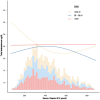Gender-specific negative association between serum vitamin B12 and testosterone levels in females: the modifying role of BMI in a US adult population
- PMID: 40786690
- PMCID: PMC12331471
- DOI: 10.3389/fnut.2025.1579531
Gender-specific negative association between serum vitamin B12 and testosterone levels in females: the modifying role of BMI in a US adult population
Abstract
Background: An increasing number of studies have highlighted the potential role of vitamin B12 in hormonal health, especially its relationship with testosterone levels. Nevertheless, studies examining the association between vitamin B12 and testosterone, particularly in the general population and among women, remain scarce. Using data from National Health and Nutrition Examination Survey (NHANES) 2011-2014, this study aimed to investigate the relationship between vitamin B12 and testosterone levels.
Method: Data for this study were obtained from the NHANES conducted between 2011 and 2014. Multivariable linear regression models were employed to evaluate the associations between vitamin B12 levels and testosterone concentrations in adult participants.
Results: The final study cohort consisted of 4,571 participants with a mean age of 48 ± 18 years. Among them, 50.8% were male, and 49.2% were female. Multivariable weighted linear regression revealed a significant inverse association between serum vitamin B12 levels and testosterone concentrations in females. This association was observed across all three models, including the unadjusted model (β = -0.010, 95% CI -0.016 to -0.005), adjusted model I (β = -0.007, 95% CI -0.013 to -0.002), and adjusted model II (β = -0.008, 95% CI -0.014 to -0.002). Additionally, body mass index (BMI) was identified as an effect modifier, demonstrating a significant negative interaction (β = -0.021, 95% CI -0.032 to -0.010) between serum vitamin B12 and testosterone in women aged 20 to 39 years. No statistically significant associations were found between serum vitamin B12 concentrations and total testosterone levels in either the male population or the overall population.
Conclusion: This study demonstrated that serum vitamin B12 levels were negatively associated with testosterone concentrations in the female population, whereas no significant association was observed in males. Moreover, BMI was found to significantly influence the relationship between vitamin B12 and testosterone levels.
Keywords: BMI; NHANES; reproductive health; testosterone; vitamin B12.
Copyright © 2025 Zhao, Lyu, Wang, Li, Peng and Zhang.
Conflict of interest statement
The authors declare that the research was conducted in the absence of any commercial or financial relationships that could be construed as a potential conflict of interest.
Figures


Similar articles
-
First-trimester maternal folate and vitamin B12 concentrations and their associations with first-trimester placental growth: the Rotterdam Periconception Cohort.Hum Reprod. 2025 Aug 1;40(8):1485-1494. doi: 10.1093/humrep/deaf095. Hum Reprod. 2025. PMID: 40373185 Free PMC article.
-
Vitamin B12 Is Associated with Higher Serum Testosterone Concentrations and Improved Androgenic Profiles Among Men with Infertility.J Nutr. 2024 Sep;154(9):2680-2687. doi: 10.1016/j.tjnut.2024.06.013. Epub 2024 Jun 26. J Nutr. 2024. PMID: 38936552 Free PMC article.
-
The relationship between flavonols intake and stroke in the elderly: a cross-sectional study from NHANES (2007-2010 and 2017-2018).J Stroke Cerebrovasc Dis. 2025 Aug;34(8):108373. doi: 10.1016/j.jstrokecerebrovasdis.2025.108373. Epub 2025 Jun 7. J Stroke Cerebrovasc Dis. 2025. PMID: 40490174
-
Folic acid with or without vitamin B12 for cognition and dementia.Cochrane Database Syst Rev. 2003;(4):CD004514. doi: 10.1002/14651858.CD004514. Cochrane Database Syst Rev. 2003. Update in: Cochrane Database Syst Rev. 2008 Oct 08;(4):CD004514. doi: 10.1002/14651858.CD004514.pub2. PMID: 14584018 Updated.
-
Sex and gender as predictors for allograft and patient-relevant outcomes after kidney transplantation.Cochrane Database Syst Rev. 2024 Dec 19;12(12):CD014966. doi: 10.1002/14651858.CD014966.pub2. Cochrane Database Syst Rev. 2024. PMID: 39698949
References
-
- Ognjenovic M, Ambrosini GL, Malacova E, Doherty DA, Oddy WH, Handelsman DJ, et al. Associations between major dietary patterns and testicular function in a population-based cohort of young men: results from the Western Australian pregnancy cohort (Raine) study. Andrology. (2019) 7:273–80. doi: 10.1111/andr.12598, PMID: - DOI - PubMed
LinkOut - more resources
Full Text Sources

